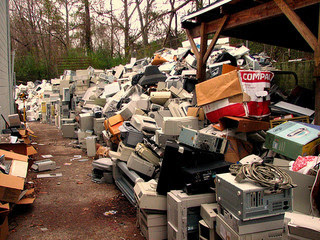India processes over 800,000 tons of e-waste every year. The electronic gadgets that we use and take for granted everyday generally end up dumped in areas where they are not recycled or reused, contaminating the environment with toxic components. Considering the amount of iPhones, iPads, TVs and other electronic equipment we go through, it is a serious environmental concern that deserves greater attention in the wider media.
 |
| photo: curtis palmer via Flikr creativecommons 2.0 |
In recent years especially, there has been a push among some organizations such as Greenpeace, non-profit Toxics Leak as well as other environmental campaigns to bring greater attention to the e-waste issue. It is gaining traction in both the United States and India where e-waste disposal is big business. There is a campaign in the US to pass a law that would make it the responsibility of the makers of smartphones, TVs and refrigerators to ensure their e-waste is cleanly disposed of after being used.
India has a far bigger problem. Places like China and the US have more high tech facilities to deal with e-waste. In India, its disposal in landfill is highly prevalent, along with the resulting damaging effects to the environment. It is a highly profitable business for those importing used gadgets for disposal in the country and the Indian government has attempted to ban the practice by making it illegal to import used computers into the country.
Many have gotten around the law by importing under the guise of "donations". The amount of e-waste which has been dumped in landfill is of increasing concern. Greenpeace India is working especially hard to help increase standards of e-waste disposal in the country to both protect the environment and the people who are working to dispose of toxic material.
It is often cheaper for large multinational companies to ship materials to India for disposal rather than deal with it through recycling or disposing of it in a more environmentally friendly way. With four million tons of e-waste placed in US landfills each year, it is clear that something needs to be done to make better use of the materials and electronic component parts.
A system has to be put in place so that wasted electronic components can be put to better use. The first part of any sorting process should be to reuse operational component parts by providing them to those who don't have the money for brand new gadgets and devices. If broken, a device that can be reused should be repaired or refurbished. When a device cannot be repaired, usable component parts can be salvaged. Any e-waste left over should be recycled if it can, or if not, disposed of in landfill which does not effect the environment around it. These processes are simple enough but yet an amazingly high amount of tech prodcuts are wasted, just for the sake of convenience. What more do you think could be done in the area of e-waste?
David Tully has written many articles on green issues, including Bright Green Talent, a popular resource for green jobs.
No comments :
Post a Comment